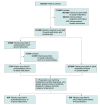Association of Intravenous Acetaminophen Administration With the Duration of Intravenous Opioid Use Among Hospitalized Pediatric Patients
- PMID: 34932106
- PMCID: PMC8693214
- DOI: 10.1001/jamanetworkopen.2021.38420
Association of Intravenous Acetaminophen Administration With the Duration of Intravenous Opioid Use Among Hospitalized Pediatric Patients
Abstract
Importance: Adoption of multimodal pain regimens that incorporate nonopioid analgesic medications to reduce inpatient opioid administration can prevent serious opioid-related adverse effects in children, including tolerance, withdrawal, delirium, and respiratory depression. Intravenous (IV) acetaminophen is in widespread pediatric use; however, its effectiveness as an opioid-sparing agent has not been evaluated in general pediatric inpatients.
Objective: To determine if IV acetaminophen administered prior to IV opioids is associated with a reduction in the total duration of IV opioids administered compared with IV opioids administered without IV acetaminophen in general pediatric inpatients.
Design, setting, and participants: This comparative effectiveness research study included data on pediatric inpatients from 274 US hospitals between January 2011 and June 2016 collected from a national database. Outcomes were compared with a propensity score-matched analysis of pediatric inpatients administered IV opioids without IV acetaminophen (control) and those administered IV acetaminophen prior to IV opioids (intervention). Data were analyzed from January 2020 through October 2021.
Exposures: Patients in the intervention group received IV acetaminophen prior to IV opioids. Patients in the control group received IV opioids without IV acetaminophen.
Main outcomes and measures: Total duration of all IV opioids administered during a patient's hospitalization.
Results: Of 893 293 pediatric inpatients, a total of 104 579 were included in analysis (median [IQR] age, 1.3 [0-14.7] years; 59 806 [57.2%] female; 21 485 [21.5%] African American, 56 309 [53.8%] White), of whom 18 197 (2.0%) received IV acetaminophen, and 287 504 (34.0%) received IV opioids. After applying exclusion criteria, among patients who received IV acetaminophen, 1739 (10.8%) received IV acetaminophen prior to IV opioids within a median (IQR) treatment time of 1.5 (0.02-7.3) hours. After propensity score matching produced comparable groups in the control and intervention groups (with 839 patients in each group), the multivariable model estimated a 15.5% shorter duration of IV opioid use in the intervention group, with an absolute IV opioid reduction of 7.5 hours (95% CI, 0.7-15.8 hours).
Conclusions and relevance: In this comparative effectiveness study, IV acetaminophen administered prior to IV opioids was associated with a reduction in IV opioid duration by 15.5%. Multimodal pain regimens that use IV acetaminophen prior to IV opioids could reduce IV opioid duration.
Conflict of interest statement
Figures
References
-
- Patel AK, Trujillo-Rivera E, Faruqe F, et al. . Sedation, analgesia, and neuromuscular blockade: an assessment of practices from 2009 to 2016 in a national sample of 66,443 pediatric patients cared for in the ICU. Pediatr Crit Care Med. 2020;21(9):e599-e609. doi:10.1097/PCC.0000000000002351 - DOI - PMC - PubMed
-
- Harris J, Ramelet AS, van Dijk M, et al. . Clinical recommendations for pain, sedation, withdrawal and delirium assessment in critically ill infants and children: an ESPNIC position statement for healthcare professionals. Intensive Care Med. 2016;42(6):972-986. doi:10.1007/s00134-016-4344-1 - DOI - PMC - PubMed
Publication types
MeSH terms
Substances
LinkOut - more resources
Full Text Sources
Medical


